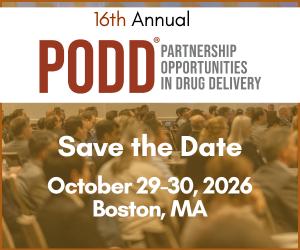New Processes Enabling the Development and Commercialization of Long-Acting Injectables
Julien Bérard, Corbion’s Global Director Business Development Biomaterials, discusses how recent developments in material chemistry and artificial intelligence are enabling the development, regulatory approval and commercialization of new long-acting injectable therapeutics.

How is the long-acting injectable space evolving?
As world populations get older and more people have access to healthcare, the need to develop therapies to treat chronic diseases increases. Long-acting injectables are a nice approach because they consist of single injections that deliver drugs over a long period of time, allowing treatment adherences while reducing the burden on patients. Reducing the frequency of treatment also reduces the cost to the overall healthcare system while still offering the same level of treatment.
The problem is that long-acting injectables have historically been difficult to develop and get approved. Over the last thirty years, there have been some developments but very few new concepts have reached the market. Recently, there have been new developments in chemical processing technologies and artificial intelligence and machine learning to unlock alternatives for the future.
How is AI beginning to take on the long-acting injectable space?
When you look at long-acting injectables using bioresorbable polymers, PLGA copolymers are the standard in the field because they are based on natural compounds and therefore degrade into compounds the body can metabolize. But those polymers are difficult to make and difficult to characterize and there are a lot of interactions between polymer-intrinsic properties and the therapeutic product behavior. At the same time, those long-acting injectables are microparticles which are complicated to master, copy, scale up and make commercial in a viable way.
With machine learning, you can train a database with a lot of inputs and learn critical process parameters and critical material attributes that will affect the performance of your drugs. This allows us as an industry to accelerate our speed of learning and optimization. At the same time, we have standardized some of the processes to make these depots, which makes consistent scale up much easier. By reducing the number of variables in our development process while increasing our knowledge on the impact of those variables in the design of our product, we have now gotten to a sweet spot where the science can really accelerate. While the concept itself is not new, technology has developed towards enabling long-acting injectable development and commercialization.
"By reducing the number of variables in our development process while increasing our knowledge on the impact of those variables in the design of our product, we have now gotten to a sweet spot where the science can really accelerate."
Are there regulatory implications with these new opportunities?
Regulatory agencies like the FDA have grown their knowledge around PLGA-based long-acting injectables for the past few decades. We are working with a material that has existed for decades and has been demonstrated as safe. Regulators have actually sponsored research to continue learning about and facilitate the better development of such products. The FDA will ask that you justify your process control to monitor critical polymer attributes, critical excipient attributes and critical manufacturing process parameters so that your product is consistent and safe. With these learnings about PLGA, you can now quickly integrate that into your development process and build the right documentation to support your IND or NDA submission.
It’s also worth noting that long-acting injectables can be reformulations of existing drugs. Therefore, you do not need to reproduce data from the initial drug approval and can instead follow the 505(b)(2) pathway that accelerates the development timeline.
Are there new long-acting injectable concepts or products coming through the pipeline?
There is currently a lot of focus on making sure that the generics being developed will actually reduce cost for long-acting injectables and improve treatment access for patients while improving adherence. One example is Vivitrol, an opioid management type of product. You can imagine that an implant or long-acting therapeutic would improve adherence and improve recovery efficacy for someone with substance use disorder. If we can drop the cost by leveraging generics and long-acting technologies, we can provide real benefits to patients.
Similarly, in the prevention of malaria, there are people working on a long-acting version of ivermectin that can remain in the system for a week or a month. If you can prevent a village from having malaria cases for one point of time, you can be relatively certain that that population won’t get malaria for a significant amount of time later.
How have payers generally reacted to long-acting injectables?
You need to be able to justify the reimbursement based on the cost of the disease. For instance, if you can prevent a total knee replacement surgery by effectively managing chronic osteoarthritis and a monthly injection further reduces the degeneration more than a daily oral medication would because of the improved patient adherence, you can figure out a complex formula that supports the cost savings to the health system and justify a set price.
"If we can drop the cost by leveraging generics and long-acting technologies, we can provide real benefits to patients."
What is coming down the pipeline that excites you?
We are always working on improving our PLGA polymers and developing and expanding our portfolio to assure a certain versatility in reducing interactions with the drug. We are also working on hydrophilic, longer-duration polymers.
When an innovation is made in the bioresorbable space, we carefully evaluate the probability of the excipient to be approved because many innovators in the materials science field design fancy materials without a realistic path to approval. We work on getting those materials and that technology up to GMP grade in a stepwise approach with partners during the development process to minimize risk while ensuring a continuity of supply of high-quality real polymers.
In this article









